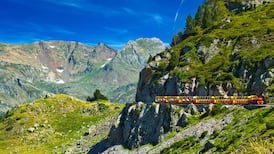Deirdre McQuillanexplores the small volcanic island often described as Madeira's best kept secret
'WE'LL BURY you in the sand, but we won't kill you", I was assured by a man from Lisbon I met one sunny day recently in January in Porto Santo. It was a promise rather than a threat, for the sand on this tiny island 75 miles from Madeira is known for its therapeutic properties particularly in alleviating arthritis and rheumatism.
It is not unusual, according to locals, to see older people buried up to their necks on the island's beach, though all I saw on my visit was a sinewy old lad doing cartwheels along the sand and the remains of a recent burial mound. Whether the two were connected or not I never found out.
Porto Santo has been called Madeira's best kept secret and while a summer playground for Madeirans, who outnumber the 5,000-strong locals at the height of the season, it receives significantly fewer visitors during the winter months.
Just 11 km long and 9km wide, Porto Santo is small and volcanic but much older than Madeira. Flat and arid, it is geographically a contrast to Madeira's lush, tropical vegetation.
It was discovered in 1419 by young Portuguese explorers working for Henry the Navigator who took refuge there after a storm and named it "Sacred Port" before laying claim to the island they had seen in the distance, Madeira. Some years later Christopher Columbus took up residence in its sleepy little capital Vila Baleira before moving to Funchal. His house is now a museum.
So much for the history. These days you can get to Porto Santo on a two-hour trip by cruise ship from Madeira. However, in January the boat goes for maintenance to the Canary Islands, so the only access is by air on a short rather expensive 20-minute flight from Funchal. It leaves early in the morning and the day I went it was packed with construction workers, engineers and architects carrying map plans and drawings, evidence of its future development and changes afoot to attract more tourists.
The island's undoubted jewel is the nine kilometre beach with not a stone nor a scrap of seaweed to mar its long unspoilt stretch on the south west. There are no fishing boats here since l990 when a 25,000 ton oil spill from a tanker devastated its marine life. It took six year to clean up the beach and there is a prohibition on fishing to allow the regeneration of the ecosystem. The process will continue for several decades to come.
In the meantime, everybody is talking about the lavish new five-star Colombos resort due to open later this year. Fifty per cent of the initial investors in this extensive development are Irish.
To boost off-season tourism, the island authorities recently spent €70m on an 18-hole golf course designed by Seve Ballesteros, but despite the sunny, beautiful weather on my visit, there was nobody on the greens other than a lonesome caddy and the beach was deserted except for a handful of people walking along the shore. It seemed so extraordinary after the crowds and dense development in Madeira.
Sofia Santos took me on a trip around the island from the lovely point of Calheta, at its western end, up to Cidade de Vella, verdant with introduced plantations of Aleppo pine where we saw eagles, hawks and grouse. From that viewpoint, the craggy windswept peaks on the wild north cloaked with primeval black drapes of volcanic lava are an eerie sight.
Porto Santo has its own version of the Giants Causeway too, with extraordinary striated rock formations discovered in the l980s that locals call the "piano". Even their lovely windmills that used to grind grain are unusual, built on rotating pivots so sails face the wind.
It's a quiet, relaxed place and the curious can find lots of things to do if the beach isn't a sufficient attraction such as windsurfing, tennis, diving, snorkelling, horseriding or golf. There's a wonderful ice cream parlour from the l940s in the capital's pretty cobbled centre and a great bar called Apollo where you can taste the local wine beside a popular restaurant called Baiana. Simple cafes and restaurants are tucked discreetly into the dunes. A new museum Cardina telling the history of the island though thousands of everyday objects opened last summer.
But back to the man from Lisbon. He was Dr Paulo Moreira, general manager of the Hotel Porto Santo. He is the throes of completing a "geo-medical" spa centre adjoining the hotel to exploit the unique beneficial qualities of the local sand.
Moreira reckons it will be the only one of its kind in the world and that a two-week treatment involving sand immersion for half-an-hour twice a day will relieve arthritic or rheumatic pain for a minimum of 9-10 months afterwards. Porto Saude could be the island's new name.
The places to look out for
Where to stay
Hotel Porto Santo was built in l961. Its 94 bedrooms don't face the sea, but it has worn its years well and is right on the beach. www.hotelportosanto.com
Vila Baleira is a bigger complex aimed at families with apartments, suites and various facilities. www.vilabaleira.com
Where to eat
O Calhetas at the western end is a quiet restaurant overlooking the sea.
Pe na Agua - right on the beach, candlelit at night.
Solar do Infante - at the harbour's edge with a lovely balcony overlooking the beach.
Go there
Aer Lingus operates scheduled flights between Dublin and Madeira and from there you can take a cruise ship to Porto Santo (approximately €55 return).
Alternatively, shuttle flights operated by Sata from Funchal, Madeira's airport, run to Porto Santo daily, costing around €140 return for the 20-minute flight.
The UK based Atlantic Holidays (www.atlanticholidays.net) is offering seven-night packages to Porto Santo direct from Gatwick from May starting at £499 (€634)










